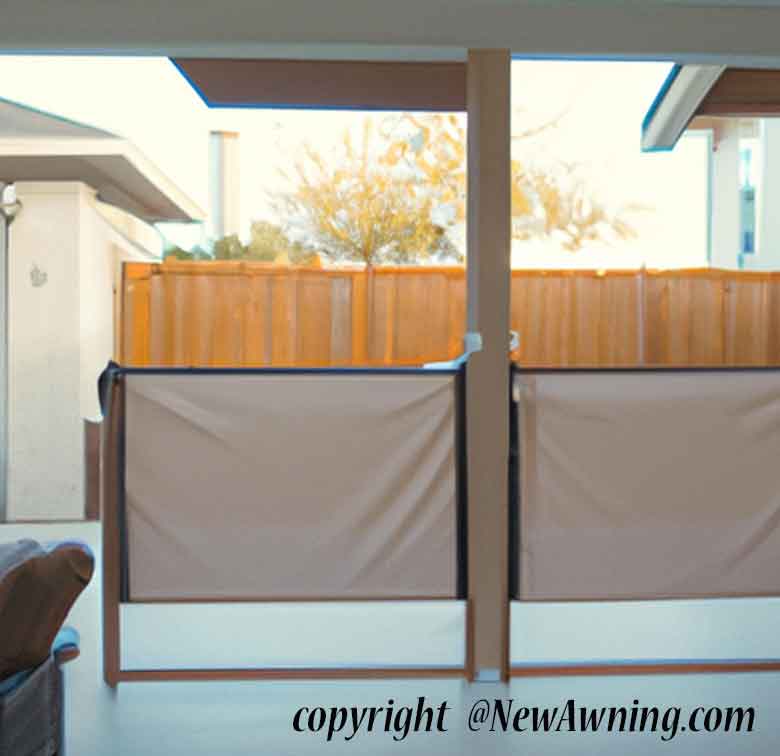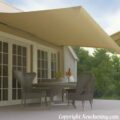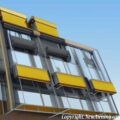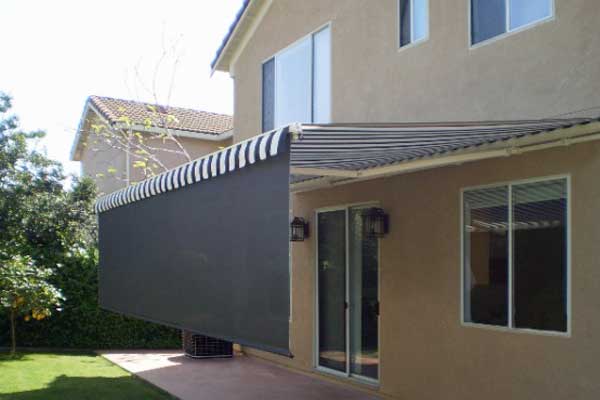Last Updated:April 07, 2024
Cattle Shading Guide – Everything You Need to Know About Livestock Shade

We live in Arizona where temperatures can get over 110 degrees in the summers. Even with the heat, it is still a very large agricultural state with a lot of livestock including cows, goats, lamas, and alpacas.
We don’t claim to be expert farmers, but we do care about animals. If our knowledge of shades can help any owner or animal deal with the summer heat, it will be worth the time we spent writing this article.
Livestock shading research
There have been recent studies done by the Australian government which measured the impact for both dairy cows and beef cattle.
They have discovered that excessive heat can lead to a significant reduction in milk production as well as considerably lower meat yield. The precise metric is this is a ratio of the pounds of meat from the cow per pound of grain consumed. This is simple biology as the calories obtained from the food are used by the cow to maintain body temperature.
We are not experts on biology or raising livestock, but I do feel it’s important to report the findings of those whose are. Livestock shading is a technique that really became popular from this study. There have been several companies that now manufacture and sell these awnings for livestock. This can benefit other animals too; however, nearly all the research has been focused on the financial impact for cows.
What are the benefits of livestock sun protection?
The main reason a farmer wants to protect his herd from the sun is to maintain a consistent body temperature for the cattle.
While 98.6 degrees Fahrenheit is the average temperature for humans, the average for cows run a tad higher ranging between 101.5 and 102.7 depending on the breed.
Additionally, the majority of the heat generated by cattle comes through eating and digesting. Because of the best place to provide overhead protection from the sun is around the hay bails or feed stalls.
If the cows are free range and roam around an open field, then you can either use stationary awnings at the salt blocks or water stations or portable awnings distributed around the field.
We will cover the portable livestock shade options below as these are one of the most effective and best value tools to help you regulate your cow’s temperature.
Some reported negative effects of overheated cattle
The list below is a compilation of many sources that have researched this topic. In order for you to decide on the impact it may have on your herd, I have chosen to include a link to the source study each time.
Livestock shading is a technique that really became popular from this study. There have been several companies that now manufacture and sell these awnings for livestock. This can benefit other animals too; however, nearly all the research has been focused on the financial impact for cows.
We have created a list of the impact and corresponding benefits that shade can provide to your herd.
- Milk Production: Extreme heat can reduce production by 1.5 liters per cow. (Source)
- Milk Protein Production: Milk protein per liter drop by 0.15% (Source)
- Lean Beef Mass: This can drop 10% for adult cows (Source)
- Conceptation Rate: For year round calfers, the conception rate can decrease by 10% to 12% (Source)
- Gestation Length: The usual cycle range from 279 to 284 with a mean of 283. Heat stress can add 1-3 days to this average. (Source)
- Calf Size: Initial research has suggested a decrease in birth weight; however, we have not found a peer reviewed scientific study. (Source)
What are the benefits of livestock sun protection?
The main reason a farmer wants to protect his herd from the sun is to maintain a consistent body temperature for the cattle. While 98.6 degrees Fahrenheit is the average temperature for humans, the average for cows run a tad higher ranging between 101.5 and 102.7 depending on the breed. Additionally, the majority of the heat generated by cattle comes through eating and digesting. Because of this the best place to provide overhead protection from the sun is around the hay bails or feed stalls. If the cows are free range and roam around an open field, then you can either use stationary awnings at the salt blocks or water stations or portable awnings distributed around the field. We will cover the portable livestock shade options below as these are one of the most effective and best value tools to help you regulate your cow’s temperature.We have created a list of the impact and corresponding benefits that shade can provide to your herd.
What is the ROI Impact?
Most of the large farmers that we have spoken with already use a software to measure their ROI. For these farmers, we encourage them to plug in the data to their existing systems. There are are many government-funded research projects that provide independent validation to the changes. From there, it’s merely a matter of comparing that with the cost of adding the awnings to your farm.
For small farmers who may not have the software tools, we recommend creating a DIY solution first.
This can either be a portable residential style awning that is attached to the side of a barn to see if they cows go to the shaded area. Additionally, you can compare this with the Year over Year milk production for days of similar temperature.
For farmers who do “Skip Day” milking the impact seems to be even more significant to overall milk production. If you are going with the DIY residential option, we highly recommend a permanent, non-retractable awning that can be kept up most of the year.
In the summers, the awning will protect the cattle from the heat whereas in the winter it will shield them from the impacts of the snow or rain by providing a dry place for them to stand as we know a lot of the small farms don’t have dedicated barn space.
Our top recommendation is the Super Amazing Cow Shade, but we hope you’ll get some shade for the cows, goats or alpaca even if you don’t take our suggestion or simply use very budget friendly tarp from Walmart to provide relief for the animals.
Risks to livestock overheating
The list below is not meant to create an alarm or panic. It is taken from the Australian study referenced above.
There are obviously levels before a cow will fall over and die. The list below will hopefully allow you to see the symptoms before anything becomes significant enough to cause long-term damage.
- Increased Respiration Rate
- Wandering for Shade
- Eating Less
- Swarming Water Sources
- Splashing Water from Trough on Body
- Multiple Cows Clumping for Shade
- Open Mouth Heavy Breathing
- Drooling from Mouth
- Fall Over
- Convulsions
- Death
Best Cool Weather Strategies
While most of this article is about keeping cows cool in the summer months, there are also benefits from keeping the cattle warmer during the winter. Cows lose heat through three main methods, and these are:
- Convection – This is when a cow touches something cooler such as the ground or shaded wall.
- Conduction – This is when cows heat up the air around them. This is the primary benefit from cattle awnings.
- Radiation – This is the heat from getting solar radiation. This is irrespective of temperature, and being in shade can lower this by more than 50%.
Best Warm Weather Strategies
The one item we want to call out when evaluating any terms of movable covers is that they can sometimes be caught by the wind so it is extremely important to have them attached well to the ground.
If you are on a parking lot or other paved area, we recommend tent weights. For the times you are on a beach, you can use sandbags that are tied to the legs, and if you are camping in a grassy or wooded area, additional tent stakes are the preferred option as they can secure your structure to the ground without adding significant weight to your pack.
Regardless of what environment that you are using the tent on, it is better to err on the side of attaching better than not enough.
Heat Exchange in Cows
Standalone awnings are ideal for RVs because they can easily be pulled from the vehicle and placed adjacent to it.
This will create extra usable living space, and it will also create a welcoming social spot.
For people who frequent RV parks, a portable awning is a must have.
DIY Cattle Awnings
While this applies to a small number of visitors, the question I have received most is about portable shading options for pets or livestock so I have created an entire section on this.
Once we complete additional research, I will break this out into its own page so we would love to hear if you have any specific experience with a product either good bad. Finally, we appreciate any time you can send us an image as it really helps our information come to life. While researching this article, we found an amazing YouTube video where a farmer created a multi-purpose livestock shade structure for around $600.
You can view the video below:
Professional Awnings for Livestock and Horses
While this applies to a small number of visitors, the question I have received most is about portable shading options for pets or livestock so I have created an entire section on this.
Once we complete additional research, I will break this out into its own page so we would love to hear if you have any specific experience with a product either good bad. Finally, we appreciate any time you can send us an image as it really helps our information come to life.
Best Sizes for Cattle Shade Structures
While this applies to a small number of visitors, the question I have received most is about portable shading options for pets or livestock so I have created an entire section on this.
Once we complete additional research, I will break this out into its own page so we would love to hear if you have any specific experience with a product either good bad. Finally, we appreciate any time you can send us an image as it really helps our information come to life.
Conclusion
Thank you for reading this entire post. It took me several days to create, and it isn’t really monetized. I didn’t do it for that reason. My parents grew up on a farm, and I don’t want to see any animal suffer.
If I can take a few hours out of my life and share information to help farmers or families who have outdoor animals as pets, I will definitely consider it a win.
Also, if you find more information on protecting animals from the sun, I’d love to hear them. Feel free to send us a tweet or DM to us @NewAwning.




